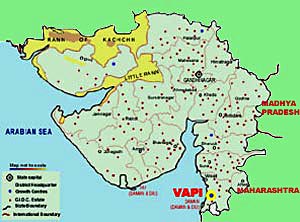 Vapi, a city and a municipality in Valsad district in the Indian state of Gujarat, is best known for its industrial growth. It is situated on the banks of Damanganga River in southern Gujarat and Vapi falls under the taluka administration of Pardi.
Vapi, a city and a municipality in Valsad district in the Indian state of Gujarat, is best known for its industrial growth. It is situated on the banks of Damanganga River in southern Gujarat and Vapi falls under the taluka administration of Pardi.
The strategic location of Vapi is around 28 km south of the district headquarter city of Valsad and is bordered by Union Territories of Daman on the west and by Dadra and Nagar Haveli on the east. Economic and industrial growth of the recent years has, however, distorted the physical boundaries. The small stretch of roughly 21 km of Daman-Vapi-Silvassa has almost become a monolith. The industrial township of Vapi holds its place of importance in India and it is the largest industrial area also in Asia in regards to small-scale industries, dominated by chemical industry plants, along with their frequent hazards.
National Highway 8 bisects Vapi, thus creating east and west parts - the western part is the original old town-place, and the eastern part mainly hosts the industries and the newly constructed residential areas. Mumbai is about 180 km to the south and the city of Surat is about 125 km to the north, if traveled across the modernised highway. To cater to the industry, Vapi handles a huge amount of population and the Vapi railway station on the Mumbai-Vadodara rail link of Western Railway (India) has become the direct receiver in terms of revenues due to daily passengers.
The Arabian Sea lies about 7 km to the west of Vapi, where the Daman Ganga River creates its delta. The city has tropical weather and thus enjoys three distinct seasons of mild winter, moderate summer and heavy monsoon, with rainfall that ranges from 100 inches to 120 inches per annum. In addition to the old city, some of the other main residential areas and suburbs of Vapi are Vapi Town, Gunjan, Chanod Colony, Hariya Park, Chala and also up coming Balitha n Salvav with many other small areas.
Owing to the proximal distance to the larger cities of Mumbai and Surat, attached with liberal Government policy, has helped Vapi and surrounding areas in attaining their present level of industrial growth. The "Vapi Industrial Estate" was started by GIDC in 1967, and has spread to 11.4 km² and his home to over 1500 industries, the majority of which are small-scale units (SSIs). Presently almost 70% of the total industries in the township are chemical plants, mainly for chemical distillation and the production of pesticides, dyes, dye intermediaries and paints. Other major industries include paper, packaging, plastics, pharmaceuticals, rubber, textiles, glass, wood, and food products. Another striking feature of Vapi is the Comman Effluent Treatment Plant (or CETP). This is the largest of its kind in Asia, treating the pollutants from these industries before the effluent is released in the Daman Ganga River.
Vapi is an Indian city that enjoys magnificent geographical location and is surrounded by some magnificent location around it like Daman & Diu, Dadra & Nagar Haveli, Umbergaon, Sarigam, Bhilad, Udavada, Sanjan, Pardi. Silvassa. Premises of Vapi are rich with prospering Union territories and places like Sarigam, Bhilad, Umbergaon and Pardi, which are good residential cum commercial areas, situated near Vapi with a mere distance of 12-40 km. Daman and Silvassa is not only a magnificent attraction for tourist in India but they have been successful enough to attract people from other countries even. Vapi has recorded a vital entry in Gujarat`s and India`s success story.
For complete business listing of Vapi visit Vapi Yellowpages



















